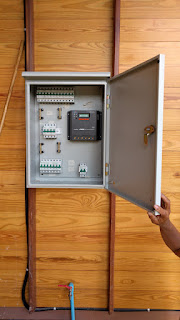We had a number of delays in setting up the main solar for BaanMae. At first we were going to mount everything inside the house and use DC automotive fuses for protection. But we began to realize that many of the devices we wanted to power were outside, such as the water pumps and walkway lighting. So we ended up deciding to mount it outside. Then we bought the wrong box size, although that was easy enough to fix.
Finally, it took us a while to find a reliable supplier of DC circuit breakers for solar setups. An interesting aside here about AC vs DC switches…
I did some research into understanding the difference between “AC 220V rated switches” and “DC <whatever>V rated switches”. The best advice I got was to not use an AC rated switch for a given DC load unless the manufacturer specifically tells you what the DC load rating is. There are rules of thumb out there, but who wants to trust their house not burning down to a rule of thumb?
I am no expert in this field so the usual caveat of “you are just reading my experiences and all of this is intended for informational purposes only and you take full responsibility for anything you do with this information” applies. It is worth reminding readers that this applies to all information on this blog whether this disclaimer is added in or not. I do projects and I write about them. I don’t take any responsibility for what you do.
With that out of the way… my understanding is that the voltage required to start an arc is much higher than the voltage required to maintain an arc. And all switches arc when they are disconnected. There is some moment when the contacts disconnect for some infinitesimal distance which requires infinitesimal voltage to create an arc. Then, as the contacts separate, it requires a relatively large separation to stop the arcing. If the load is a DC load. For an AC load, the voltage and current cross zero every hundredth of a second (for a 50Hz AC source), although not necessarily at the same time. I believe it is when the zero current crossing occurs, the arc has to stop (since no current means no electrical charge to arc). And once the arcing stops, it takes a relatively large voltage to start the arcing again.
What is the moral of this story? Don’t use any kind of switch with only AC ratings on a DC source. And a circuit breaker is also a kind of switch.
So we found this distributor of DC circuit breakers here in Thailand. It turns out they are not too far from the land so I sent someone to pick up what we needed. At first we thought we would need to buy boxes to mount these circuit breakers, so we bought a few of these from them also. But this turned out to be yet another digression on our road to installing our solar setup. The boxes are little more than a rail to mount the circuit breaker on, and since we wanted to mount everything in one giant box, all we needed was the rail. And pommm introduced me to “DIN rails“. It turns out our normal industrial electrical supply shop sells these by the meter. So we bought a meter.
And finally, we got a chance to mount everything. Here are a few pictures:
Now that it is all mounted, with enough space around the solar controller to comply with the mounting requirements in the manual (for air flow over the heatsink), we still have to wire it all together. Lots of wiring. I won’t have much time to spend on this over the next day or two, so I will try checking in frequently and guiding K’Tanawat through the process. I’m really glad I have K’Tanawat to help me on this.
I guess sometimes a project turns out to have more twists and turns and delays and false starts than most projects. But that just means I’m learning more for next time. 🙂


